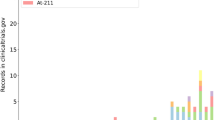Abstract
Purpose
2-[18F]Fluoro-2-deoxy-D-glucose (18F-FDG) is a widely used PET radiotracer for the in vivo diagnosis of several diseases such as tumours. The positrons emitted by 18F-FDG, travelling into tissues faster than the speed of light in the same medium, are responsible for Cerenkov radiation (CR) emission which is prevalently in the visible range. The purpose of this study is to show that CR escaping from tumour tissues of small living animals injected with 18F-FDG can be detected with optical imaging (OI) techniques using a commercial optical instrument equipped with charge-coupled detectors (CCD).
Methods
The theory behind the Cerenkov light emission and the source depth measurements using CR is first presented. Mice injected with 18F-FDG or saline solution underwent dynamic OI acquisition and a comparison between images was performed. Multispectral analysis of the radiation was used to estimate the depth of the source of Cerenkov light. Small animal PET images were also acquired in order to compare the 18F-FDG bio-distribution measured using OI and PET scanner.
Results
Cerenkov in vivo whole-body images of tumour-bearing mice and the measurements of the emission spectrum (560–660 nm range) are presented. Brain, kidneys and tumour were identified as a source of visible light in the animal body: the tissue time-activity curves reflected the physiological accumulation of 18F-FDG in these organs. The identification is confirmed by the comparison between CR and 18F-FDG images.
Conclusion
These results will allow the use of conventional OI devices for the in vivo study of glucose metabolism in cancer and the assessment, for example, of anti-cancer drugs. Moreover, this demonstrates that 18F-FDG can be employed as it is a bimodal tracer for PET and OI techniques.







Similar content being viewed by others
References
Mamede M, Higashi T, Kitaichi M, Ishizu K, Ishimori T, Nakamoto Y, et al. [18F]FDG uptake and PCNA, Glut-1, and hexokinase-II expressions in cancers and inflammatory lesions of the lung. Neoplasia 2005;7:369–79.
Kurokawa T, Yoshida Y, Kawahara K, Tsuchida T, Okazawa H, Fujibayashi Y, et al. Expression of GLUT-1 glucose transfer, cellular proliferation activity and grade of tumor correlate with [F-18]-fluorodeoxyglucose uptake by positron emission tomography in epithelial tumors of the ovary. Int J Cancer 2004;109:926–32.
Miller TR, Pinkus E, Dehdashti F, Grigsby PW. Improved prognostic value of 18F-FDG PET using a simple visual analysis of tumor characteristics in patients with cervical cancer. J Nucl Med 2003;44:192–7.
Higashi T, Tamaki N, Torizuka T, Nakamoto Y, Sakahara H, Kimura T, et al. FDG uptake, GLUT-1 glucose transporter and cellularity in human pancreatic tumors. J Nucl Med 1998;39:1727–35.
Farace P, D’Ambrosio D, Merigo F, Galiè M, Nanni C, Spinelli A, et al. Cancer-associated stroma affects FDG uptake in experimental carcinomas. Implications for FDG-PET delineation of radiotherapy target. Eur J Nucl Med Mol Imaging 2009;36:616–23.
Lindholm P, Minn H, Leskinen-Kallio S, Bergman J, Ruotsalaien U, Joensuu H. Influence of the blood glucose concentration on FDG uptake in cancer—a PET study. J Nucl Med 1993;34:1–6.
Cho JS, Taschereau R, Olma S, Liu K, Chen YC, Shen CKF, et al. Cerenkov radiation imaging as a method for quantitative measurements of beta particles in a microfluidic chip. Phys Med Biol 2009;54:6757–71.
Cerenkov PA. Visible emission of clean liquids by action of γ radiation. C R Dokl Akad Nauk SSSR 1934;2:451–4.
Robertson R, Germanos MS, Li C, Mitchell GS, Cherry SR, Silva MD. Optical imaging of Cerenkov light generation from positron-emitting radiotracers. Phys Med Biol 2009;54:N355–65.
Spinelli AE, D’Ambrosio D, Calderan L, Marengo M, Sbarbati A, Boschi F. Cerenkov radiation allows in vivo optical imaging of positron emitting radiotracers. Phys Med Biol 2010;55(2):483–95.
Liu H, Ren G, Miao Z, Zhang X, Tang X, Han P, et al. Molecular optical imaging with radioactive probes. PLoS One 2010;5(3):e9470.
Ruggiero A, Holland JP, Lewis JS, Grimm J. Cerenkov luminescence imaging of medical isotopes. J Nucl Med 2010;51:1123–30.
Galiè M, Sorrentino C, Montani M, Micossi L, Di Carlo E, D’Antuono T, et al. Mammary carcinoma provides highly tumourigenic and invasive reactive stromal cells. Carcinogenesis 2005;26:1868–78.
Galiè M, D’Onofrio M, Montani M, Amici A, Calderan L, Marzola P, et al. Tumor vessel compression hinders perfusion of ultrasonographic contrast agents. Neoplasia 2005;7:528–36.
Galie M, Farace P, Nanni C, Spinelli AE, Nicolato E, Boschi F, et al. Epithelial and mesenchymal tumor compartments exhibit in vivo complementary patterns of vascular perfusion and glucose metabolism. Neoplasia 2007;9:900–8.
Jelley JV. Cerenkov radiation and its applications. London: Pergamon; 1958.
Spinelli AE, D’Ambrosio D, Pettinato C, Trespidi S, Nanni C, Ambrosini V, et al. Performance evaluation of a small animal PET scanner. Spatial resolution characterization using 18F and 11C. Nucl Instrum Methods Phys Res A 2007;571:215–8.
Hudson HM, Larkin RS. Accelerated image reconstruction using ordered subsets of projection data. IEEE Trans Med Imaging 1994;13:601–9.
Defrise M, Kinahan PE, Townsend DW, Michel C, Sibomana M, Newport DF. Exact and approximate rebinning algorithms for 3-D PET data. IEEE Trans Med Imaging 1997;16:145–58.
Virostko J, Powers AC, Jansen ED. Validation of luminescent source reconstruction using single-view spectrally resolved bioluminescence images. Appl Opt 2007;46:2540–7.
Sokoloff L, Reivich M, Kennedy C, Des Rosiers MH, Patlak CS, Pettigrew KD, et al. The [14C]deoxyglucose method for the measurement of local cerebral glucose utilization: theory, procedure, and normal values in the conscious and anesthetized albino rat. J Neurochem 1977;28:897–91.
Acknowledgments
The authors would like to thank Dr. M. Galiè, who provided us with BB1 cells and Dr. F. Gerosa who kindly let use the radioactive laboratory of the Department of Immunology of the University of Verona.
We would like also to acknowledge Dr. Stefano Boschi and the Radiopharmacy Department of the Policlinico S. Orsola-Malpighi (Bologna) for providing the radiotracers.
Conflicts of interest
None.
Author information
Authors and Affiliations
Corresponding author
Rights and permissions
About this article
Cite this article
Boschi, F., Calderan, L., D’Ambrosio, D. et al. In vivo 18F-FDG tumour uptake measurements in small animals using Cerenkov radiation. Eur J Nucl Med Mol Imaging 38, 120–127 (2011). https://doi.org/10.1007/s00259-010-1630-y
Received:
Accepted:
Published:
Issue Date:
DOI: https://doi.org/10.1007/s00259-010-1630-y




